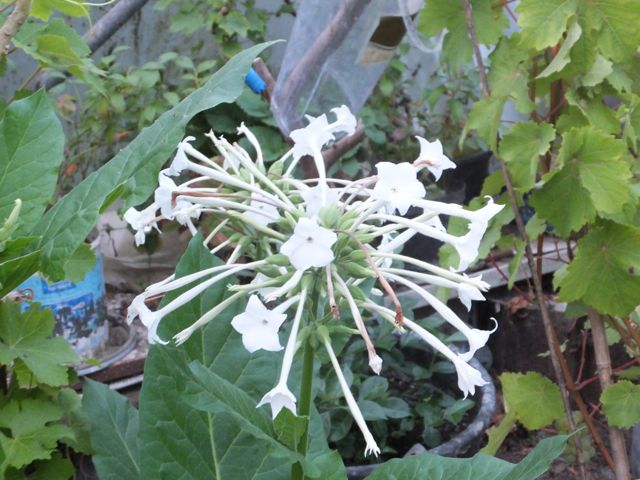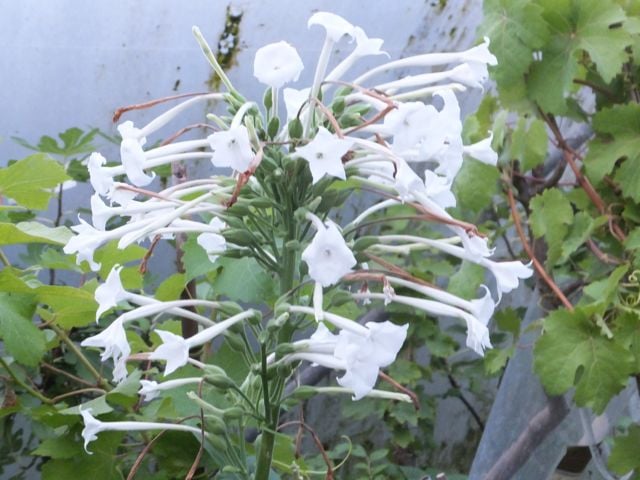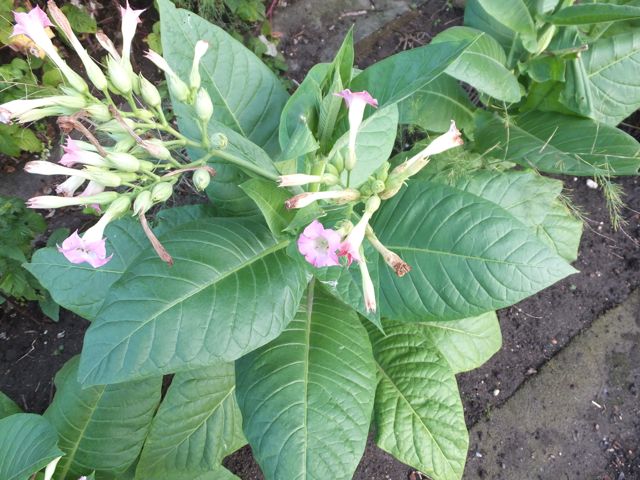
Until recently greenhouse pests were fumigated with smoke from smouldering tobacco. For nicotine kills most creatures in addition to long term damage when smoked by us foolish humans. Tobacco is now considered a rather dirty habit but the plants themselves should not be frowned upon. In the flower garden most of us probably know the knee high bedding tobaccos such as Nicotiana alata and many hybrids in pastel shades. But a species I want to recommend for your greenhouse or conservatory is much more imposing, and actually useful.
The woodland tobacco N. sylvestris has large candelabras of long pure white, fanfare-trumpet shaped blooms which erupt from the top of a pillar of decorative large leaves. These flowers are sweetly scented each evening and bloom over a long period making the plants excellent value (especially as they’re grown from seed). Now the useful bit; the leaves are ever so slightly sticky which is no problem to us but a clinging death to small critters. Thus regular inspection of a N. sylvestris plant will reveal whether any flying pests such as whitefly have arrived in your greenhouse and you can immediately take action.

Like the other tobaccos N. sylvestris is easy to grow from a spring sowing in warmth. The seed is like dust and needs sprinkling thinly over the surface of sowing compost then keeping warm and moist. The seedlings start small but once manageable after a couple of weeks can be moved into individual pots or multi-celled trays. The plants are grown on and potted up enjoying much the same compost and conditions as tomatoes. The tobaccos are closely related to tomatoes, both are in the Solanaceae family, with similar pests and diseases, and likewise both may be grown outside in summer. Most Nicotianas are tender and treated as half hardy annual summer flowerers. However kept frost free under cover in the greenhouse border or a large pot N. sylvestris becomes woody and almost evergreen. Indeed it behaves more like a Datura and may flower over many years if dead-headed after blooming.

There are other interesting flowering species such as N. affinis and N. langsdorfii and you can grow proper smoking tobacco as well. This is quite legal in the UK as an ornamental though if processed into tobacco this must be solely for your own personal use (apparently you are allowed up to 40lbs a year!).

N. tabacum Burley is the typical traditional smoking variety, very similar to but a tad larger than N. sylvestris with delicately rose flushed flowers. There are many other cultivars of N. tabacum including a brightly variegated form (attractive if you like plants that look as if they’ve been drenched in yellow paint).
Oddly the tobacco that was originally introduced to Europe and still preferred in some country regions is another species, N. rustica, a smaller plant with thicker more spinach like leaves (with a higher nicotine content) and heads of curious greeny yellowish flowers.










